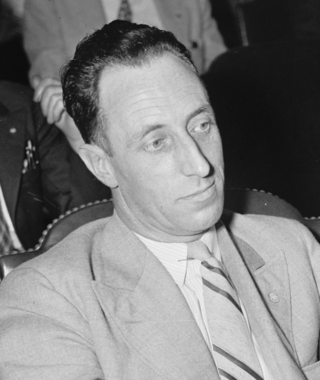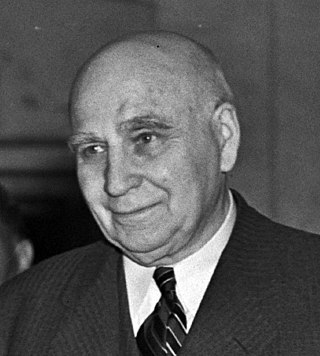Related Research Articles

The Gulf Coast of the United States, also known as the Gulf South or the South Coast, is the coastline along the Southern United States where they meet the Gulf of Mexico. The coastal states that have a shoreline on the Gulf of Mexico are Texas, Louisiana, Mississippi, Alabama, and Florida, and these are known as the Gulf States.

A dockworker is a waterfront manual laborer who is involved in loading and unloading ships.
The Port of Houston is one of the world's largest ports and serves the metropolitan area of Houston, Texas. The port is a 50-mile-long complex of diversified public and private facilities located a few hours' sailing time from the Gulf of Mexico. Located in the fourth-largest city in the United States, it is the busiest port in the U.S. in terms of foreign tonnage and the busiest in the U.S. in terms of overall tonnage. Though originally the port's terminals were primarily within the Houston city limits, the port has expanded to such a degree that today it has facilities in multiple communities in the surrounding area. In particular the port's busiest terminal, the Barbours Cut Terminal, is located in Morgan's Point.

Southeast Texas is a cultural and geographic region in the U.S. state of Texas, bordering Southwest Louisiana and its greater Acadiana region to the east. Being a part of East Texas, the region is geographically centered on the Greater Houston and Beaumont–Port Arthur metropolitan statistical areas with a combined population of 7,662,325 according to the 2020 U.S. census.

Vigor Shipyards is the current entity operating the former Todd Shipyards after its acquisition in 2011. Todd Shipyards was founded in 1916, which owned and operated shipyards on the West Coast of the United States, East Coast of the United States and the Gulf. Todd Shipyards were a major part of the Emergency Shipbuilding Program for World War II.

Harry Bridges was an Australian-born American union leader, first with the International Longshoremen's Association (ILA). In 1937, he led several chapters in forming a new union, the International Longshore and Warehouse Union (ILWU), expanding members to workers in warehouses, and led it for the next 40 years. He was prosecuted for his labor organizing and designated as subversive by the U.S. government during the 1930s, 1940s, and 1950s, with the goal of deportation. This was never achieved.

Frank Finley Merriam was an American Republican politician who served as the 28th governor of California from June 2, 1934 until January 2, 1939. Assuming the governorship at the height of the Great Depression following the death of Governor James Rolph, Merriam defeated the Democratic candidate Upton Sinclair in the California gubernatorial election in 1934. Merriam also served as the State Auditor of Iowa from 1900 to 1903, and served in both the Iowa and California state legislatures.

The 1934 West Coast Waterfront Strike lasted 83 days, and began on May 9, 1934, when longshoremen in every US West Coast port walked out. Organized by the International Longshore and Warehouse Union (ILWU), the strike peaked with the death of two workers on "Bloody Thursday" and the San Francisco General Strike which stopped all work in the major port city for four days and led ultimately to the settlement of the West Coast Longshoremen's Strike.

The International Longshoremen's Association (ILA) is a North American labor union representing longshore workers along the East Coast of the United States and Canada, the Gulf Coast, the Great Lakes, Puerto Rico, and inland waterways; on the West Coast, the dominant union is the International Longshore and Warehouse Union. The ILA has approximately 200 local affiliates in port cities in these areas.
The Battle of Ballantyne Pier occurred in Ballantyne Pier during a docker's strike in Vancouver, British Columbia, in June 1935.

The British Columbia Maritime Employers Association is an association representing the interests of member companies in industrial relations on Vancouver's and other British Columbian seaports.
The International Seamen's Union (ISU) was an American maritime trade union which operated from 1892 until 1937. In its last few years, the union effectively split into the National Maritime Union and Seafarer's International Union.

The Port of Galveston is the port of the city of Galveston, Texas, United States. It was established by a proclamation issued by the Congress of Mexico on October 17, 1825, while the land known today as Texas was still part of Mexico. The Port of Galveston is the oldest port in the Gulf of Mexico west of New Orleans.
Dockworkers in New Orleans at the turn of the 20th century often coordinated their unionization efforts across racial lines. The nature of that coordination has led some scholars to conclude that the seeming interracial union activity was in fact biracial: a well-organized plan of parallel concerted activity with coordination and support between the groups, but with a clear divide along racial lines.

Charles L. Smith was the Mayor of Seattle, Washington from March 6, 1934 to 1936.

The International Longshore and Warehouse Union (ILWU) is a labor union which primarily represents dock workers on the West Coast of the United States, Hawaii, and in British Columbia, Canada; on the East Coast, the dominant union is the International Longshoremen's Association. The union was established in 1937 after the 1934 West Coast Waterfront Strike, a three-month-long strike that culminated in a four-day general strike in San Francisco, California, and the Bay Area. It disaffiliated from the AFL–CIO on August 30, 2013.
The 1923 San Pedro maritime strike was, at the time, the biggest challenge to the dominance of the open shop culture of Los Angeles, California until the rise of the Congress of Industrial Organizations in the 1930s.
The Portland Waterfront strike of 1922 was a labor strike conducted by the International Longshoremen's Association which took place in Portland, Oregon from late April to late June 1922. The strike was ineffective at closing down the Port of Portland due to strikebreakers, and on June 22 the strike ended with the employers dictating terms.

In the late 1870s, Squamish and Tsleil-Waututh communities on the North Shore of Burrard Inlet experienced an increase of physical and economic encroachment from the expansion of neighbouring Vancouver. Faced with urbanization and industrialization around reserve lands, Squamish and Tsleil-Waututh traditional economies became increasingly marginalized, while government-imposed laws increasingly restricted Native fishing, hunting, and access to land and waters for subsistence. In response, these communities increasingly turned to participating in the wage-labor economy.
The 1936 Gulf Coast maritime workers' strike was a labor action of the splinter union "Maritime Federation of the Gulf Coast" lasting from October 31, 1936 to January 21, 1937. The strike's main effects were felt in Houston and Galveston.
References
- ↑ Roth, Mitchel P.; Kennedy, Tom (2012). Houston Blue: The Story of the Houston Police Department. University of North Texas Press. p. 99. Retrieved 15 April 2017.
- ↑ Willett, Don (March 1994). "The Galveston Bay Dock Wars, 1936-1937". East Texas Historical Journal. 32 (1). Retrieved 15 April 2017.
- ↑ Willett, Don (March 1994). "The Galveston Bay Dock Wars, 1936-1937". East Texas Historical Journal. 32 (1). Retrieved 15 April 2017.
- ↑ Gilbert, Mers (1 January 1988). Working the Waterfront: The Ups and Downs of a Rebel Longshoreman. University of Texas Press. p. 162. ISBN 9780292760226 . Retrieved 15 April 2017.
- ↑ Francis, Robert C. (1 December 1935). "The Crisis". NAACP. Retrieved 15 April 2017.
- ↑ Roth, Mitchel P.; Kennedy, Tom (2012). Houston Blue: The Story of the Houston Police Department. University of North Texas Press. p. 100. ISBN 9781574414721 . Retrieved 15 April 2017.
- ↑ Boessenecker, John (26 April 2016). Texas Ranger: The Epic Life of Frank Hamer, the Man Who Killed Bonnie and Clyde. Macmillan. pp. 447–8. ISBN 9781250069986 . Retrieved 15 April 2017.
- ↑ Willett, Don (March 1994). "The Galveston Bay Dock Wars, 1936-1937". East Texas Historical Journal. 32 (1). Retrieved 15 April 2017.
- ↑ "Gulf to Put 1075 Men Back to Work". Port Arthur News. 9 November 1935. Retrieved 25 April 2017.
- ↑ "Young Striker is Shot to Death on Houston Waterfront". Bixoli Daily Herald. 26 November 1935. Retrieved 15 April 2017.
- ↑ "First Fatality in Dock Strike in New Orleans". Anniston (AL) Star. 5 October 1935. Retrieved 25 April 2017.
- ↑ "Striker Killed in Fight Near Docks". The Port Arthur News. 21 October 1935. Retrieved 14 April 2017.
- ↑ Marshall, F. Ray (1967). Labor in the South. Harvard University. p. 204. ISBN 9780674507005 . Retrieved 14 April 2017.
- ↑ "Gulf to Put 1075 Men Back to Work". Port Arthur News. 9 November 1935. Retrieved 25 April 2017.
